 French Navy Pre-Dreadnought Battleship: FS République, Patrie (1901-1905)
French Navy Pre-Dreadnought Battleship: FS République, Patrie (1901-1905)WW1 French Battleships:
Duperre class | Terrible class | Amiral Baudin class | Hoche | Marceau class | Charles Martel class (1891) | Charlemagne class | Henri IV | Iena | Suffren | Republique class | Liberté class | Danton class | Courbet class | Bretagne class | Normandie class | Lyon classThe many shortcomings of the previous classes, born under the Jeune Ecole influence was highlighted and for the first time in 1899 a homogeneous class of battleships was planned, six ships total, but only two first ships, République and Patrie were ordered, the remainder four under a modified design with bigger guns. The first ones were not launched until 1902-03, completed in December 1906 and were already outdated as HMS Dreadnought had just come out. However, they were a very significant improvement over previous classes in many areas, with a greater displacement, speed, armour, better secondary armament in turrets, and a more efficient hull without tumblehome. The next four Liberté were near sisters with a heavier secondary battery. They had a career in the Mediterranean 1st squadron until replaced in the 2nd after the Dantons entered service. In WWI they saw action escorting troopships, roaming the Adriatic to lure out the Austro-Hungarians (and the battle of antivari), took part in the Dardanelles and Gallipoli campaign, in the actions in Greece in 1916-17 and were based in Mudros until the end of the war, becoming training ships postwar, Republique being decommissioned in 1921 and her sister Patrie in 1924, but survived as target ship until 1937. #ww1 #frenchnavy #marinenationale #greatwaratsea #gallipoli #dardanelles #battleship

Patrie in North Africa, Bougault coll.
Development of the République class battleships
Jeune Ecole and shipbuilding limitations
The “hotels” as popularly dubbed in modern social medias and even a popular meme about French battleships prior to WWI is partly grounded in the “new school” theories, and following a logic dictated by elderly and under-funded infrastructures. The main problem of the French shipbuilding industry for almost two decades is that no effort was made to modernize and increase the size of shipyard dry-docks. They were considered a private matter relevant to each yard’s own business, not to be subsidized by the state, and the latter of course to keep their prices low when answering tenders, avoided any investment, which also explained their very long construction time, in addition to frequent design changes.
Still, to resume what the Jeune Ecole (Young or more appropriately “new” School) was about, it is necesary to undestand that its root went back further in time, to the need make with to a limited budget after the defeat of 1870 against Prussia. This war thrown the Marine Nationale, which dwarved the Prussian Navy at the time to the Baltic in order to try blockading Germany, but it failed, having no logistic support far from its bases and Britain still trading with Prussia. This supposed inefficiency coupled with austerity to pay a massive war indemnity to Germany had a simple result, boosting French Army reforms, but also limiting the Navy’s budget in a considerable way. It was to make due with only a small fraction of what was available in the 1860s.
To meet these new conditions in 1880 it was looked after a way to offset the imbalance (notably towards Britain, soon a rising German Navy, then later Italy) by playing technological advantages. This an earlier form of thinking but it had even more distant roots like the Paixhans shells in 1860, as well as steamships of the line (1850) and Gloire, the first sea going ironclad. But this was before 1870 when Napoleon III had a very large conventional battle fleet directed at Britain.

Jaureguiberry, 1897, an example of all French Battleships pre-century oddities.
This search for technological advantage just bounced again afterwards, under this time Admiral H.L. Theophile Aube, which was Minister of Marine i 1886-87 and temporary halted construction of battleships. To make it short, a heavy focus on torpedoes, commerce raiding with armoured cruisers, and longer range, quick firing guns. Coastal defence with dedicated battleships and rams, but emphasis was placed in torpedo boats and later submersibles to offset the first torpedo boat destroyers. As for battleships, which was restarted again after a vacancy, it was plagued by the lack of experience and small dockyards which imposed a peculiar arrangement with a typical tumblehome, and single turrets in a lozenge arrangement instead of fore and aft twin main guns. Despite the efforts, French battleships became rapidly obsolete when delivered, top heavy, too slow, compounded by the absence of standards, leading to the famous “prototype navy” which inherited the new Minister of Navy in 1898, Édouard Locroy.
The 1898 naval expansion Program
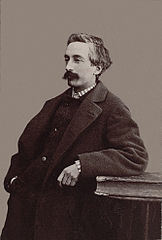 Well before the reforms of Boué de Lapeyrière in 1909 as a MoM, back in 1898, Lockroy was an advocate of a strong naval policy in opposition of Admiral Aube’s Jeune Ecole supporters, and published “La Marine de Guerre” in 1890 a burning critic of the Jeune Ecole, especially their pledge in considering the other side not answering its advantages, ‘Six mois rue Royale’ in 1897, and after his minister, “La Défense navale” in 1900 and in 1904 “Les Marines française et allemande, a warning comparative of the state between the French and German Navies, as well as the “Programme naval” in 1906 for a better planification. Lapeyriere built on this, to launch the French dreadnought programme. Alas, the lack of further investments in infrastructure also plagued the latter until WWI. Back in 1898, Lockroy planned a massive naval expansion program to answer the rise of German warship construction through the German Naval Law the same year, and it called for six new modern battleships, which became the République and Liberté class.
Well before the reforms of Boué de Lapeyrière in 1909 as a MoM, back in 1898, Lockroy was an advocate of a strong naval policy in opposition of Admiral Aube’s Jeune Ecole supporters, and published “La Marine de Guerre” in 1890 a burning critic of the Jeune Ecole, especially their pledge in considering the other side not answering its advantages, ‘Six mois rue Royale’ in 1897, and after his minister, “La Défense navale” in 1900 and in 1904 “Les Marines française et allemande, a warning comparative of the state between the French and German Navies, as well as the “Programme naval” in 1906 for a better planification. Lapeyriere built on this, to launch the French dreadnought programme. Alas, the lack of further investments in infrastructure also plagued the latter until WWI. Back in 1898, Lockroy planned a massive naval expansion program to answer the rise of German warship construction through the German Naval Law the same year, and it called for six new modern battleships, which became the République and Liberté class.
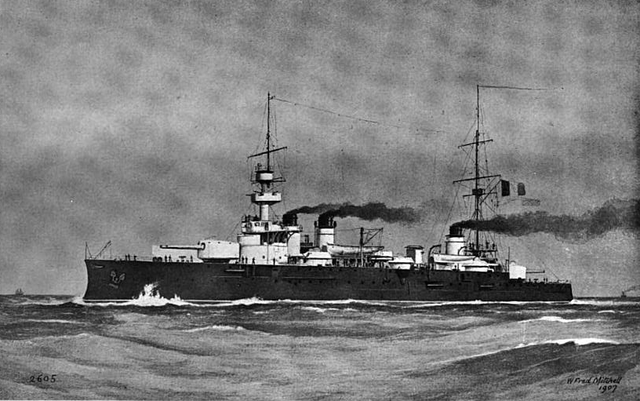
Illustration of République in Brassey’s naval annual
The whole class, including République and Patrie, were designed by famous French naval engineer Louis-Émile Bertin. The new battleships were a significant improvement over previous designs, and although carrying the same four 305 mm (12 in) guns, they were now in twin turrets fore and aft (this was done on Suffren already), and eighteen fast firing 164 mm (6.5 in) guns mounted in gun turrets, not in casemates. They were also larger overall, thanks to Arsenal de Brest and Société Nouvelle des Forges et Chantiers de la Méditerranée (FCN) receiving incentives to invest in dockyard construction. A longer and larger hull cured all issues of previous designs, notably the typical tumblehome, enabled larger barbettes for twin mounts fore and aft, and enough room to fit more boilers, feeding larger and more capable triple expansion engines, resulting in a better top speed and extra range.
The use of turreted upper deck secondary guns made them more flexible with a better arc of fire being well above the sea, less limited in heavy weather. The Atlantic and North sea were indeed their expected battleground. They also a more effective armor protection arrangement. More so the design was not revised during construction, and calculations enabled to keep and optimal draught and belt’s depth when fully loaded and thus, maintaining protection. Stability remained good despite the largely flat side hull, thanks in part to Bertin’s underwater compartmentation design, with extra measures taken against flooding.
Design
Hull and general design of the République class battleships
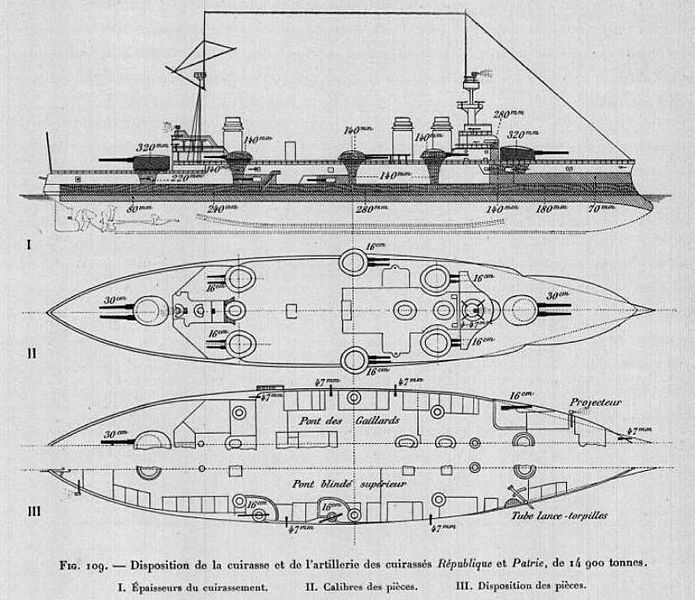
The two sisters were 131 m (429 ft 9 in) long at the waterline and 133.8 m (439 ft) long between perpendiculars, 135.25 m (443 ft 9 in) long overall. Their beam was 24.25 m (79 ft 7 in) at the waterline and an average draft of 8.2 m (26 ft 11 in). This was an increase of 20% compared to her forebears, albeit Suffren was already quite large at 125.91 x 21.42 x 8.22 m (413 x 70 x 27ft).
Also control of specifications for once was quite vigorous to endure both naval yard would respect it. Both ships as a result needed to be completely identical, but this was not achieved, at least in displacement. The République-class displaced indeed as designed 14,870 metric tons (14,640 long tons).
However they started to diverge after completion, with République being lighter, displacing 14,605 metric tons (14,374 long tons) fully loaded, and Patrie 600 tonnes more at 14,900 metric tons (14,660 long tons). It seems the management of their internal compartmentation and ballasts fillings were to blame. The hull design however did not came from nowhere. Engineers looked at improving top speed and modelled it on a cruiser’s hull, the Gloire-class that Bertin designed. The basic hull was just made beamier, and still divided into 15 watertight compartments below the lower armor deck, with Bilge keels added for extra stability.
République and Patrie had a tall forecastle deck extending all the way to the mainmast for the first time. There was a small foremast with fighting top and spotting top, but lighter pole mast for the mainmast aft which was a big change to usual French practice, also to master stability. The forward superstructure comprised a four-deck structure around the forward mast and conning tower. The charthouse and commander’s quarters as well as the main enclosed bridge and open bridge aboce were located in a relatively well mastered space. Their three funnels were immediately recoignisable and placed them apart any other battleships of the time, with two close to the foremast and bridge and one close to the mainmast aft.
In service, this arrangement however was problematic. The conning tower was too small for example to accommodate the staff and only affored the helmsman and two officers. The bridge wings were too low and had obstructed views aft (aldo fields of fire). The commander thus had to leave the conning tower to the bridge to really have a sense of what was happening around. In 1912–1913, these wings were removed outright, but no change was done with the CT, which was disued for all her career, apart for storage. The aft superstructure also had a too low rear fire control system and wings.
They full complement consisted in 32 officers and 710 ratings and as flagship, this added 12 officers and 55 enlisted men with the admiral’s staff. To save them, there were no less than eighteen small boats on board, a menagerie including pinnaces, cutters, dinghies, whalers, and punts. Most of these were located aft amidships, between the 2nd and tirdg secondary turrets. Two were under davits, the rest was managed by a boom crane, albeit hampered by the third funnel. There was also an admiral’s gig and another cutter plus three more whalers.
Protection of the République class battleships
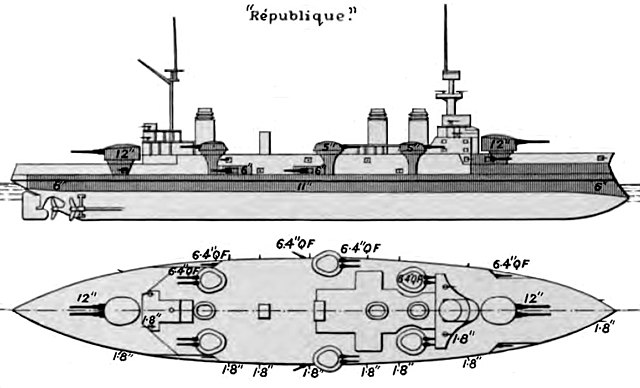
Belt armor:
This comprised two strakes of cemented steel 280 mm (11 in) thick amidships, tapared fown to 180 mm (7.1 in) at both ends pas the citadel/main barbettes. The belt however stopped short of the stern, closed by a transverse bulkhead 200 mm (7.9 in) thick, backed by 80 mm (3.1 in) of teak planking, then two layers of 10 mm (0.39 in) steel plating to create a sandwich. Forward there was no such thing as the outer belt extended to the bow.
This belt was 0.5 m (1 ft 8 in) below the waterline and 2.3 m (7 ft 7 in) above. On its upper edge it tapered to 240 mm (9.4 in).
There was also a thinner strake for the upper hull, up to the main deck and 1st deck made of 64 mm (2.5 in) of steel plating, backked by 80 mm of teak planking. It ended at the forward main battery barbette, closed by a 120 mm (4.7 in) bulkhead.
Deck Armor:
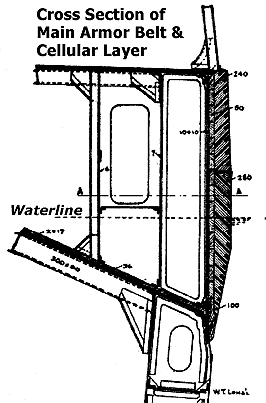 The Horizontal protection comprised two armored decks one after the other. The upper deck was located at main deck level and covered the internals from the bow to the aft transverse bulkhead. It was composed of a sandwich of three layers of 18 mm (0.71 in) steel for 54 mm (2.1 in) total with absorbing materials in between. The lower, main armoured deck at the waterline was flat over the engine and boiler rooms and composed of a similar sandwich arrangement but with layers of 17 mm (0.67 in) steel for 51 mm (2 in). The deck was a limited turtleback style, angling down to connect to the lower edge of the main belt. These slopes were composed of two layers of 36 mm (1.4 in) steel. Between the two decks and behind the main waterline belt Bertin designed his trademark subdivided cofferdam to limit flooding. The coffedam was completely sealed, filled with cork or anothjer buoyant material; but Coal storage bunkers were located immediately behind this cofferdam to absorb remaining shell splinters, armor fragments.
The Horizontal protection comprised two armored decks one after the other. The upper deck was located at main deck level and covered the internals from the bow to the aft transverse bulkhead. It was composed of a sandwich of three layers of 18 mm (0.71 in) steel for 54 mm (2.1 in) total with absorbing materials in between. The lower, main armoured deck at the waterline was flat over the engine and boiler rooms and composed of a similar sandwich arrangement but with layers of 17 mm (0.67 in) steel for 51 mm (2 in). The deck was a limited turtleback style, angling down to connect to the lower edge of the main belt. These slopes were composed of two layers of 36 mm (1.4 in) steel. Between the two decks and behind the main waterline belt Bertin designed his trademark subdivided cofferdam to limit flooding. The coffedam was completely sealed, filled with cork or anothjer buoyant material; but Coal storage bunkers were located immediately behind this cofferdam to absorb remaining shell splinters, armor fragments.
Main-battery turrets
These had the heaviest armor: The turret themselves had a cylindrical shape with flat sides, and these tall gunhouses were covered by 360 mm (14 in) walls on the sides gradually tapering down to 280 mm at the back. These were made in cemented steel. These walls were even backed by two layers of 20 mm (0.79 in) thick steel of diferent composition to absorb impact shrapnels. The roof comprised three layers of 24 mm (0.94 in) of steel.
Main barbettes
They were 246 mm (9.7 in) thick aboce the waterline, and 66 mm (2.6 in) below deck: Forward barbette there was a transitional 166 mm (6.5 in) level as the hull sides were only covered by the thin upper belt.
secondary turrets
. Of prismaric and not cylindrical shape, they had a cone like upper section and inverted cone for their barbettes below. The upper secion was covered by 138 mm (5.4 in) cemented steel faces, sides 246 mm (9.7 in) in mild steel, to counterbalance the weight of the guns, projecting forward. The secondary turret roof had three layers of 13 mm (0.51 in) steel plating.
Persumably the low section, acting as barbettes, had the same thickness.
Secondary casemates:
They were located on the lower battery deck above the main arour belt, and protected by 140 mm (5.5 in) thick walls, and backed with two layers of 10 mm milder steel. In these, the guns themslves were shielded by a similar thickness of 140 mm.
Forward conning tower
It was protected by 266 mm (10.5 in) steel forward and on both side, then 216 mm (8.5 in) on the back, in which was cutout the main door opening. Internally they were backed by two layers of 17 mm plating, always to absorbe shrapnel, and like for all internal walls, compounded by a very thick ruberrized coat of white paint, also to absorb remaining shrapnels. The conning tower door was itself shielded by a curved bulkhead 174 mm (6.9 in) thick. Behind it was a heavily armored tube 200 mm thick to connect to the the transmitting station below, and then down to 20 mm on two layers of 10 mm steel.
Powerplant of the République class battleships
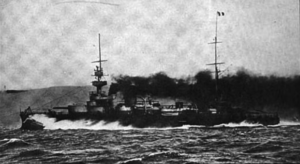 The République class were powered by three vertical triple-expansion steam engines, fed by no less than twenty-four Niclausse boilers. République (Brest Yard) diverged from her sister by having four-cylinder engines, Patrie (FCM) had three-cylinder models. Boilers were imposed the same fortunately, and were divided into four boiler rooms. The forward three were trunked into two funnels, the aft ones ducted into a single rear funnel, fara apart. The two-stage funnels with caps were identical to thiose of contemporary armoured cruisers and stayed the same until 1911.
The République class were powered by three vertical triple-expansion steam engines, fed by no less than twenty-four Niclausse boilers. République (Brest Yard) diverged from her sister by having four-cylinder engines, Patrie (FCM) had three-cylinder models. Boilers were imposed the same fortunately, and were divided into four boiler rooms. The forward three were trunked into two funnels, the aft ones ducted into a single rear funnel, fara apart. The two-stage funnels with caps were identical to thiose of contemporary armoured cruisers and stayed the same until 1911.
These Engines were located amidships, in separate watertight compartments and placed between the forward and aft groups of boilers, a peculiar arrangement tha explained why the funnels were so far apart. It was mainly to keep these very heavy pieces of kit amidship. The three shafts drove each a three-bladed screw of diverging sizes: The axial one was 4.85 m (15 ft 11 in) in diameter. But they diverged between ships for the outer propellers: République had 4.8 m (15 ft 9 in) ones and Patrie 5 m (16 ft 5 in) screws. The République class also came with six electric generators and two 500-amp generators to power the main battery turrets and ammunition hoists, as well as four 800-amp generators for all other systems. This enabled the ship to stay combat ready even in case of her engines being shut cold.
The whole propulsion system, steam alone, was rated for 17,500 metric horsepower (17,260 ihp) for a desgned top speed of 18 knots (33 km/h; 21 mph) as designed. This was a conservative figure, notably compared to the previous Suffren (17 knots or 31 km/h; 20 mph). Firtunately given their greater lenght, better shaped hull and better width ratio, their speed trials showed better performances, République being capable of 19.15 knots (35.47 km/h; 22.04 mph) based on 19,898 metric horsepower (19,626 ihp), Patrie being capable of 19.13 knots (35.43 km/h; 22.01 mph) based on 18,107 metric horsepower (17,859 ihp) showing that her 3-cylinder machinery was less efficient. Coal storage standard, peacetime, was of 900 t (890 long tons) but when filling even the cofferdams and other spaces, it could reach 1,800 t (1,800 long tons) fully loaded. Normal cruise speed was 10 kn (19 km/h; 12 mph) which enabled 8,400 nautical miles (15,600 km; 9,700 mi).
In comparison, the smaller Suffren could only reach 3,086 nmi (5,715 km; 3,551 mi) at 12 knots (22 km/h; 14 mph) so that was quite an improvement.
Armament
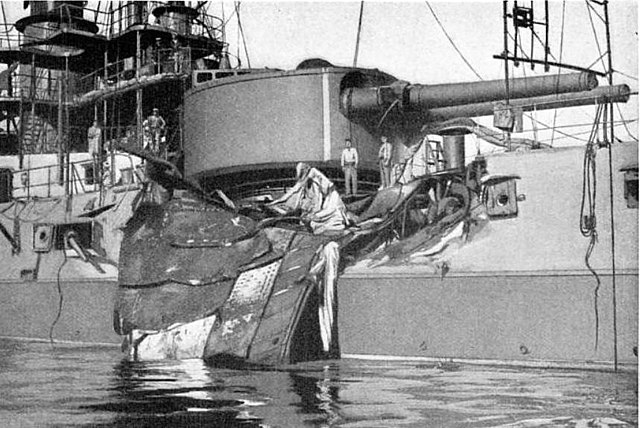
Main Battery
The main battery comprised the same main artillery as the previous Suffren, with two pairs of Canon de 305 mm Modèle 1893/96 in two twin-gun turrets forward and aft.
Specs:
Shell: 350-kilogram (770 lb) AP or HE.
Muzzle velocity: 865 meters per second (2,840 ft/s).
Range at 12°: 12,500 m (13,700 yd).
Rate of fire: One round per minute.
Both the turrets and guns were electrically operated and they were elevated together, but still could be “decoupled” if needed. The big issue for their design is that they needed to be depressed to a fixed loading position of −5 degrees between shots. This clearly impacted their rate of fire. The ready ammunition storage comprised eight rounds per turret. République and Patrie were ther first battleship with standardized APC and SAPC shells, less choice but easier management compared to Sufren and earlier designs. 65 shells, of both types were allocated for each gun or 260 total per ship, inclding 104 APC and 156 SAPC. The latter were Semi-armor-piercing, Capped, combining HE and Armour Piercing qualities, as the French still trusted their explosive rounds idea. Wartime shell supply could be ported up to 780 shells total if needed.
Secondary battery
The secondary battery was split between turreted and casemated guns. There were eighteen “Canon de 164 mm Modèle 1893 guns” in total. Twelve were placed in twin wing turrets, six in casemates, in the lower battery hull deck. The latter were subject to heavy weather obstruction, not the deck turreted guns. The latter were twon turrets with greater elevation allowing a range of 10,800 m (11,800 yd) which was not far from the main guns, and the casemate guns were only capable of 9,000 m (9,800 yd). They also had both APC and SAPC shells:
Weight: 54.9 kg (121 lb) APC and 52.3 kg (115 lb) SAPC, muzzle velocity of 900 m/s (3,000 ft/s).
Rate of fire: Three rounds per minute, electrically operated with hand elevation but loaded at any angle.
Casemate guns hand-operated only.
Light Gun Battery
The initial light anti-torpedo boat gun battery was initially comprising twenty-four 47 mm (1.9 in) guns. However this was revised during construction as it was iunderstood this model was no longer efficient. On 22 August 1905, the navy ordered t replace sixteen of these, all mounted in hull casemates, by thirteen 65 mm (2.6 in) Modèle 1902 guns capable of 15 shots per minute, maximum range 8,000 m (8,700 yd). The remaining eight 47 mm Modèle 1902 were relocated in the foremast fighting top, covering all four angles, and the forward and aft superstructure. Same rate of fire but 6,000 m (6,600 yd) range and a much lighter shell at 2 kg (4.4 lb) versus 4.17 kg (9.2 lb) for the 65 mm. Ammunition stowage was 450 rounds per gun (65 mm) or 550 shells (47 mm).
Torpedo Tubes
As customary at the time, the République class were fitted with two 450 mm (17.7 in) torpedo tubes, both underwater and abreast the forward 164.7 mm gun turrets, so out of the main protection with a fixed angle 19 degrees forward of the beam. They fired the Modèle 1904 torpedoes capable of 1,000 m (1,100 yd) at 32.5 knots (60.2 km/h; 37.4 mph) with a 100 kg (220 lb) TNT warhead.
Mines
To defend their anchorage, before nets were planned (but never installed) they had two steam pinnaces capable of mooring twenty small naval mines around the ship.
Upgrades
In 1912–1913, the two sisters received 2 m (6 ft 7 in) Barr & Stroud rangefinders from Britain to increase accuracy. Patrie later swapped these for 2.74 m (9 ft) rangefinders from the delayed dreadnought Courbet. However tests proved that wider rangefinders were more often prone to fell out of alignment, so and she was back with her 2 m versions.
In 1914, it was asked to increase the elevation of their guns for a better range, but given the turret design, it proved impractical. Main guns in the French Navy suffered from poor range right up to 1915. Some howeved advocated to use underwater compartmentation to their advantage, flooding lower compartments to reach a heel of 2 degrees, increasing artificially the main guns range from 12,500 to 13,500 m (41,000 to 44,300 ft). The Russians suffered of the same issues due to the same designs and use this “trick” in the Baltic, notably Slava.
The officers also compained the guns were too slow and thus, tests were done with new electric motors installed in the secondary turrets in 1915–1916, improving both training and elevation.
The same year, 47 mm guns on either side of the bridge as those on the aft superstructure to the roof of the rear turret for better fire arc. On 8 December 1915, it was decied to revise their light battery, down to just four 47 mm guns, eight 65 mm (2.6 in) guns and in 1916, the remaining 47 mm were replaced on high-angle AA mounts and relocated atop the rear main battery turret N°5, 6 secondary turret roofs.
In 1916, it was decided to give Patrie a single 2.74 m and two 2 m rangefinders for their primary and secondary guns respectively as well as a 0.8 m (2 ft 7 in) Barr & Stroud rangefinder for her anti-aircraft battery. Modifications on République are unknown.
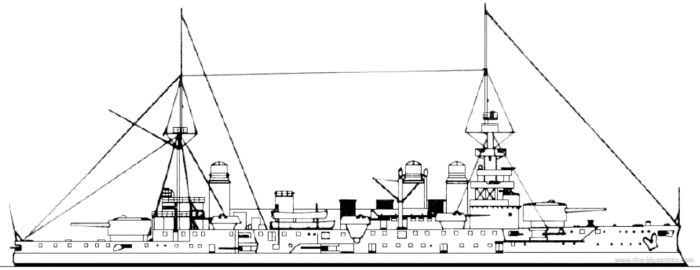
Conway’s rendition

Old author’s illustration. As completed they had the standard peacetime 1890s paint scheme, green below the waterline, black above, buff and white for the superstructure. In 1908 they were painted above with the new standard medium blue-gray and underwater by dark red.
⚙ specifications |
|
| Displacement | 14,870 metric tons (14,640 long tons) |
| Dimensions | 135.25 x 24.25 x 8.2 m (443 ft 9 in x 79 ft 7 in x 26 ft 11 in) |
| Propulsion | 3× VTE engines, 24× Niclausse boilers, 17,500 metric horsepower (17,260 ihp) |
| Speed | 18 knots (33 km/h; 21 mph) |
| Range | 8,400 nautical miles (15,600 km; 9,700 mi) at 10 knots (19 km/h; 12 mph) |
| Armament | 4× 305 M1893/96, 18× 164 mm M1896, 13 × 65 mm M1902, 8 × 47 mm Hotchkiss, 2× 450 mm TTs |
| Protection | Belt 280, Main turrets 360, Sec. turrets 138, CT 266, upper deck 54, lower deck 51 mm |
| Crew | 32 officer+ 710 enlisted men |
Evaluation and Career of the République class
In the end, they were better than previous classes, but a generation late already. They should have been built ten years before. Construction was slow, as despite preventions, there were designed changes while under construction (and average minister lasted from 6 months on average). Because of this, they were completed only by December 1906, while HMS Dreadnought was already near to completion. Added to this, the next Liberté class, still were a close copy, were redesigned (see below), further delaying new constructions until 1904-1907, pushed further with the semi-dreadnoughts of the Danton class. The latter were completed in 1908 when everybody jumped in the dreadnought bandwagon for several years already.
The French originally planned to build six, but developments abroad changed these plans. The King Edward VII-class battleships notably pioneered the new trend in “semi-dreadnoughts” or battleships with a very large secondary artillery. For the following four members it was decided to revise the plans, which led to further delays and a late launch of the next Liberté class, which secondary battery was upgraded from 164.7 to 194 mm (6.48 to 7.64 in). They were also larger and had other modifiaction, most authors separates them still. Unfortunately between the 1898 plan and various delays, they entered service just as the HMS Dreadnought came out, making them quickly obsolete.
The République class were still a quantum leap in French capital ship design: Under Bertin’s energetic conduct, as chief Constructor since 1895 and highly critical of the designs he had been forced to build due to their gross unseaworthiness and of the way their poor handling impacted operations aboard, also affectiing the fleet as a whole, he had at last his way in 1901, when the Admiralty gave him a go-ahead to produce prototypes, the République class.
With their clean lines, evident seaworthiness, and handsome proportions, these ships marked a quantum leap over previous French designs. Greatly decreased tumble-home improved stability and hull performance. Krupp cemented (KC) armor allowed more widespread protection without increased weight and as a masterful exegesis of Bertin’s ideas on armoring, this armor scheme was widely admired at the time. An efficient triple-screw steam plant delivered a reliable 19 kts and had of course greatly improved watertight subdivision over what had been common in the French navy. The ships carried all the main guns and most of their secondary ones in twin turrets, increasing their firepower and rationalizing the gunnery layout.
Despite having been built orignally to face the Germans, only Republoque had a very short time in the Atlantic and she versed in the Mediterranean Sea where both spent most of their career. In May 1907 and informal agreement with Britain and Spain after the Agadir Crisis included plans to concentrate the RN against Germany, while the French fleet with Spanish support would counter Italy and Austria-Hungary. These stayed in relevance in 1914, with the massive difference that Spain remained neutral, as Italy, and joined the entente instead in 1915. The two battleships ended in the 1st Division of the Mediterranean Squadron and Patrie became flagship. Toulon was her home port bu she also operated from Golfe-Juan and Villefranche-sur-Mer. They spend their time in routine peacetime training exercises between the western Mediterranean and Atlantic or in naval reviews, foreign ports viists,to Spain, Greece and Italy. In early 1911, the Danton-class sent them in the 2nd Squadron but Patrie remained flagship.
They also suffered accidents, a firendly torpedo hit for example, and an accidental explosion. Both vessels were Toulon in the summer of 1914, and they started by protecting troop convoys to Metropolitan France, hunter for SMS Goeben, made a sweep in the Adriatic Sea to lure the Austrians into battle and taking part in the action of Antivari. They later left the Adriatic for Corfu and Malta, saw action in the Dardanelles Division and Gallipoli campaign until January 1916, then sent Greece to pressure the pro-German government until Constantine I abdicated in June 1917. They were posted at Mudros off the Dardanelles to guard against Goeben but by January 1918 started to have guns removed for the front inland. Both became training ship. They were decommissioned in 1921, stricken for the first but Patrie remained in service until accidents in 1924 and was still used as a stationary training vessel until 1936, BU in 1937.
 République
République
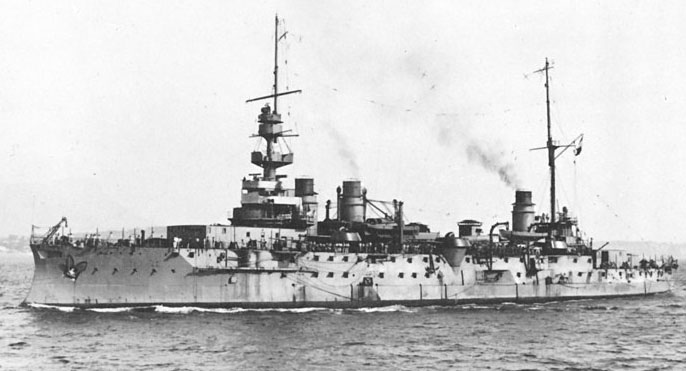
After commissioning, République exceeded her sea trials and until 26 January, she steamed from Brest to Toulon, while later performing wireless telegraphy tests with the cruiser Kléber and the Eiffel Tower (14-17 February). She arrived with the 1st Division, Mediterranean Squadron also comprising her sister and Suffren and the latter was the divisional flagship. On 1-31 July she had her first summer maneuvers, then they sailed to join the Northern Squadron for western Mediterranean exercises.
On 13 January 1908, République, Patrie, Charlemagne, Gaulois, Saint Louis, Masséna, and Jauréguiberry were based at Golfe-Juan and later Villefranche-sur-Mer for a month. IThis summer both the southern and northern squadron saw common exercises, but the Atlantic Sqn met the latter off Bizerte. The squadron then was in Villefranche by February 1909 and trained off Corsica, then had a naval review in Villefranche for President Armand Fallières (26 April). On 17 March, République, Patrie, Justice, and Liberté had shooting training on the old ironclad Tempête.
In June, République, Justice, and the cruiser cruiser Galilée sortied into the Atlantic; to meet Patrie, Démocratie, Liberté, and Ernest Renan in Cádiz on 12 June. They were to act as an attacking force for submarines posted in the Pertuis d’Antioche strait. They tested wireless off La Pallice, and had shooting training in Quiberon Bay and on 8-15 July were in Brest and Le Havre before another fleet review and sailing to Cherbourg, for another review for Czar Nicholas II. In October République and Patrie sailed to Barcelona, hosting King Alfonso XIII.
République, Patrie, Justice, Vérité, Démocratie, and Suffren took part in a simulated attack on Nice on 18 February but Patrie accidentially launched a torpedo hitting her nearby sister République, damaging her hull. She was repaired in Toulon. They trained off Sardinia and Algeria in May-4 June and had combined manoeuvers with the 2nd Squadron on 7-18 June but her crew was badly hit by an oubreak of typhoid in December, quarantined in Golfe-Juan until 15 December.
On 16 April 1911, République escorted Vérité carrying Pdt. Fallières, Navy Minister Théophile Delcassé Transport minister Charles Dumont to Bizerte. She took part in a fleet review with two British battleships, two Italian and a Spanish cruiser on 19 April, then back to Toulon on 29 April. République and her 1st Squadron teamed with the cruisers Ernest Renan and Léon Gambetta for a cruise in the western Mediterranean in May-June, stopping at Cagliari, Bizerte, Bône, Philippeville, Algiers, and Bougie. With the Danton class entering service she was versed in the 2nd Squadron comprising both the République et Liberté class, six battleships.
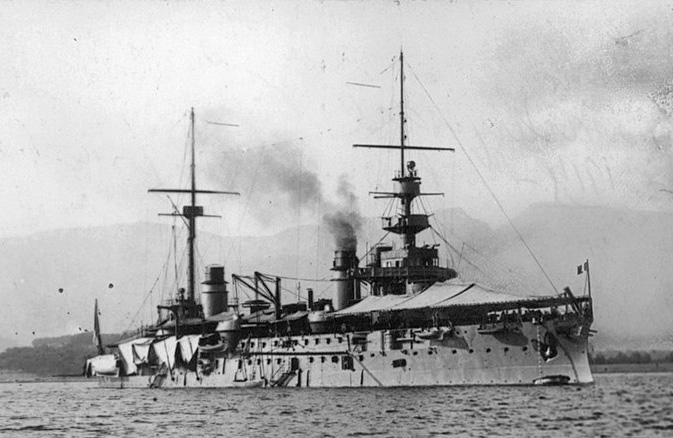
She had another fleet review off Toulon on 4 September and sailed out with Admiral Jauréguiberry on 11 September for Golfe-Juan and Marseilles and back. On 25 September, Liberté exploded while in Toulon, likely cause by Poudre B propellant whic also claimed Iéna. The force was enough to detach and propel a giganormous 37-metric-ton (36-long-ton; 41-short-ton) piece of armor plate which shrapnel its way to hit République on her starboard quarter, behind the main battery turret. The impact was enough to kill 23 men, injuring twoce as much and badly damage her side. It was found that a melinite shell from Liberté hit her, carried by the chunk of steel and exploded, punching a hole in her armored deck. A case of very odd and unique “friendly fire”… Despite this, she resumed manoeuvers and training with limited repairs.
On 24 April 1912, République was out for gunnery training off the Hyères roadstead with Patrie and Vérité. She was inspected by Admiral Augustin Boué de Lapeyrère in Golfe-Juan 2-12 July, before training off Corsica and Algeria. République at last was sent in drydock in Toulon for full repairs and refit until early April. All squadrons, sixteen modern battleships held large-scale maneuvers between Toulon and Sardinia from 19 May with a fleet review for President Raymond Poincaré, then gunnery practice. Later the 2nd Squadron left Toulon on 23 August with the cruisers Jules Ferry and Edgar Quinet plustwo destroyer flotillas for Atlantic training, stopping en route to Tangier, Royan, Le Verdon, La Pallice, Quiberon Bay, and Cherbourg and reaching Brest on 20 September to meet and train with a Russian squadron of four battleships and five cruisers. While back they stopped at Cádiz, Tangier, Mers El Kébir, Algiers, and Bizerte, ending at Toulon on 1 November followed by December torpedo training and range-finding drills until 19 January 1914. They made another cruiser Toulon-Bizerte-Toulon in February and by March, République, Démocratie, Vérité, and Justice joined the 1st Squadron and 2nd Light Squadron in Sardinia. On 30 March, the 2nd Squadron was in Malta to visit the British Mediterranean Fleet, until 3 April. News of the assassination of Archduke Franz Ferdinand and July Crisis had them rishing back to Toulon with more limited sorties.

General mobilization was annoubced on on 1 August and on the 2nd, Boué de Lapeyrère ordered the entire French fleet to rise steam in order to sortie the next day, notbly to find and neutralize the German Mediterranean Division (Goeben and Breslau) that could prey on tropo convoys from North Africa to France. The fleet was to provide “heavy escort” and the 2nd Squadron was sent to Algiers, protecting a departing fleet of seven passenger ships with 7,000 troops (XIX Corps) aboard, soon to be joined by the dreadnoughts Courbet and Jean Bart and Danton-class Condorcet and Vergniaud. Instead, Goeben bombarded Bône and Philippeville and fled east, soo to become Yavuz and Midilli in the Ottoman Navy, based in Constantinople, becoming essentially a Russian poblem in the Black sea.
On 12 August, France and Britain declared war on the Austro-Hungarian Empire and given prewar arrangement, France was to carry the bulk of operations, sending the 1st and 2nd Squadrons to the southern Adriatic Sea to contain, and later lure out at sea the entrenched Austro-Hungarian Navy in Pola. On 15 August, the two squadrons arrived off the Strait of Otranto, meeting there the cruiser HMS Defence and HMS Weymouth off Othonoi. Boué de Lapeyrère took the combined fleet into the Adriatic and they spotted a day later ships in the distance that, which revealed as the protected cruiser SMS Zenta and torpedo boat Ulan off the coast of Montenegro. The Battle of Antivari however started with warning shots, and Ulan escaped, but not the slower Zenta.
The French fleet patrolled the southern Adriatic for three days but no sortie from Pola happened, and on 17 August, Justice and Démocratie collided in heavy fog at 09:20, République towing the latter at 12:40 to Corfu and then Malta for repairs on 20 August. République sailed back to the squadron. On 1 September they shelled Austrian fortifications at Cattaro on 1 September agains trying to draw out the Austro-Hungarian fleet. On 18–19 September, the fleet steamed as far north as Lissa, bu again, nothing happened. Provocations continued in October and November, notably off coast of Montenegro, cover merchant vessels recoaling there. Next, they started rotating through Malta or Toulon due to maintenance but Corfu became their main advanced base with lots of supplied brought there, including coal. Patrols went on until late December, when an Austro-Hungarian U-boat torpedoed Jean Bart. It was then decided to withdraw the battle fleet at Navarino Bay, patrolling between Kythira and Crete until 7 May. After the Italian entered war, it was logical to claim its leads in Adriatic operations, the French handed control of operations to the Italian Regia Marina and sailed to Malta and Bizerte, the new main fleet base.
In January 1916, République joined the Dardanelles for the Gallipoli campaign in its final stage. With Gaulois she covered the evacuation from Gallipoli. Next all French pre-dreadnoughts were sent to Salonika in Greece (five République/Liberté) in the 3rd Squadron to pressure the pro-German Greek government to join the entente. King Constantine I’s wife Sophie being the sister of Kaiser Wilhelm II was part of the resistance. In June-July, the squadron patrolled between Salonika and Mudros, then moved to Cephalonia.
In August, a pro-entente group launched a coup at Noemvriana, and the French soon sent sailors parties, naval fusiliers and troops to help them. République’s own landing party landed in Athens on 1 December, however soon British and French troops were defeated by the Greek Army and armed civilians, withdrawing to their ships. This was followed by a blockade of the royalist-controlled area. By June 1917, Constantine eventually abdicated. République and Patrie were ordered to the eastern Mediterranean, Lemnos. On 17/18 November however République broke free from her anchors, ran aground in the harbor, later easily refloated by tugboats. In December the two battleships had their center and aft casemate guns removed but spent an uneventful, boring 1917. Tehchnically they had been reallocated as “anti-submarine warships”.
On 20 January 1918, news were received of an immenent sortie by the Goeben/Yavuz and République and Patrie prepared for action, but Yavuz his naval mines, while foiled the attack. République was sent to Toulon for along overdue maintenance from 29 January to 19 February, loosing two main guns that were to be replaced with new barrels, but the Arly ordered them on railcar guns instead. République was reduced from there to a training ship on 28 March 1918. Until November she had a skeleton crew. On 1 July 1919 she joined the armorers and gunners school and on 2 October 1919 was drydock to have her main battery turrets removed and 164.7 mm casemate guns, only keeping her secondary turrets. On 9 December 1920 Diderot took her place in school. She was decommissioned on 21 May 1921, stricken on 29 June sold and towed in November to Savona, for BU.
 Patrie
Patrie
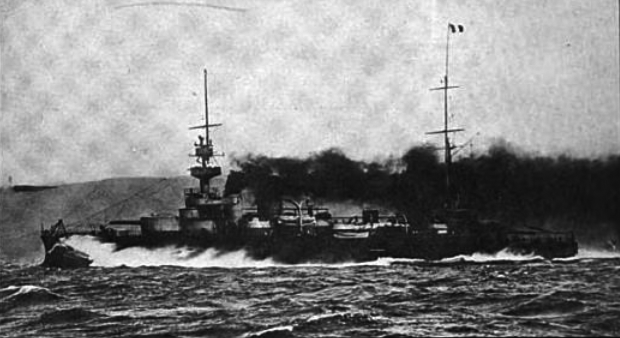
After Patrie was completed on 1 July 1907 and still fitting-out, Iéna nearby was blasted by a powerful powder B magazine explosion destroyed her entirely. Debris were projected around, and Patrie’s captained trie to flood Iéna’s drydock with her secondary guns at the dock gate, but the shell bounced off. The dock was flooded by Ensign de Vaisseau Roux (killed shortly afterward by fragments) opened the sluice gates. The flooding prevented the fire to reach other magazines and much more serious destruction. After sea trials on 29 May Patrie had a condenser pipe bursting, scalding some stokers and she was back in Toulon for repairs.
Next she was assigned to the 1st Division, Mediterranean Squadron, with République and Suffren, flagship for the division and squadron. From there, her career was similar to her sister, so no need to get back in detail on this. She was part in annual summer maneuvers, notably with the Northern Squadron replacing Suffren as flagship for Vice-amiral Germinet in 1907.
By 5 January 1909, Germinet was replaced byy VAdm Fauque de Jonquières after the first was sacked by denouncing the poor quality of the French squadron ammunition supply. In Villefranche, Patrie hosted Albert I, the Prince of Monaco on 18-24 February. On 18 February 1910 during maneuvers off Nice, Patrie torpedoed by accident République, sending her to Toulon for repairs. Meanwhile she was sent to Monaco for the opening of the Oceanographic Museum, escorted by the destroyers Coutelas and Cognée, on 29 March and back for Sqn. training off Sardinia and Algeria and later also stricken by typhoid cases in the crews by December, quanrantined into Golfe-Juan until 15 December.
Vice admiral Bellue took command on 5 January 1911 and by 16 April she sailed to Bizerte with a presidnetial delegation, an internaitonal review and manoeuvers. Presdient Fallières was so impressed by the crew’s performances he doubled the crews’ rations and suspended punishments.After a cruise to the western Mediterranean she ended in the 2nd Squadron, displaced by the Danto class.
On 25 September when Liberté exploded in Toulon, Patrie remained unscathed, not her sister. While in later exercises she was joined by the battleship Danton with Admiral Augustin Boué de Lapeyrère and the Prince of Wales aboard, being inspected on 2-12 July.
The squadron was then commande by VADm de Marolles with Patrie as flagship from on 6 January 1913. She trained off Le Lavandou and then between Toulon and Sardinia with all 16 battleships from 19 May. Next were exercises in the Atlantic and finally torpedo training on 19 January 1914, then Bizerte-Toulon in February. With the July Crisis she was in Toulon, prepared for war.
On 2 August, she was order to raise steam and was sent to Algiers to escort passenger ships carrying the XIX Corps to France. Meanwhile, Goeben did not attacked convoys and after a shore bombardment, fled eastwards, shadowed by British battlescruisers. On 12 August, the entente was at war with the Austro-Hungarian Empire and both French Squadrons ended in to the southern Adriatic, Strait of Otranto. Patrie took part in the Battle of Antivari, landing a few hits on Zenta.
She took part in the shelling of Austrian fortifications at Cattaro on 1 September and on 18–19 September was part of the sortie to Lissa and while backk shelled Cattaro’s batteries again.
After Jean Bart was torpedoed, she was withdrawn to Corfu and Malta as support base for maintenance. On 21 January 1915, Patrie sailed to Prováti and rescued the crew from a Greek steamship which ran aground. On 18 May, she hosted the new VADM Nicol and sailed for the Dardanelles Division, Gallipoli Campaign with the armored cruiser Kléber, joining the newly formed 3rd Battle Division with Suffren, Saint Louis, Charlemagne, Jauréguiberry, and Henri IV. On 12 July she took part in the attack of Achi Baba, retiring for the night to Mudros. On 2 August, she shelled Seferihisar when a faulty shell detonated in a secondary guns, wounding seven.
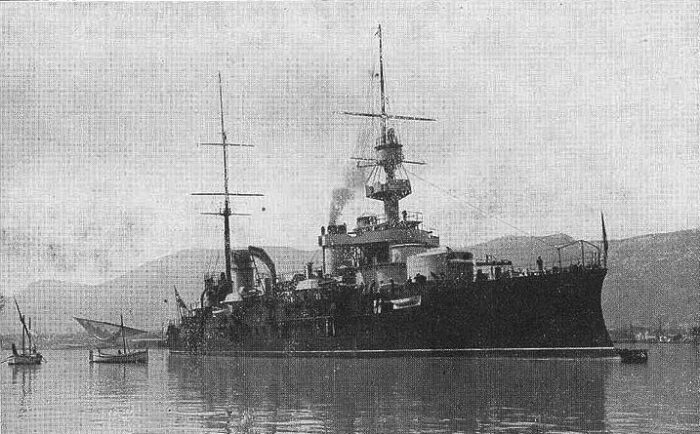
After the evacuation she was sent to Salonika in Greece starting a pressure campaign from 5 May 1916. On 9 July, she was sent for an overhaul at Toulon. She was back at Cephalonia on 1 September, patrolling off Keratsini and then the roadstead off Eleusis outside Athens on 7 October. They prepared to attack the Greek fleet (Mers el Kebir anyone ?), Patrie planning to the battleship Lemnos, a former USN pre-dreanought, another case of odd French vs US battleship engagement. But this was modified and it was decided instead to land troops and seized the ships on 19 October, avoiding a bloodbath.
In the meantime, in August, a pro-entente group made a coup and Patrie sent a landing party on 1 December support it, but it British and French troops were later defeated she instead she started a blockade until June 1917 and abdication. She was now part of the Eastern Naval Division, eastern Mediterranean, seeing her center and aft casemate guns removed but spending an uneventful 1917 until 20 January 1918 prepared to greet the Yavus, which finally sortied buy folded down after hitting a mine. On 4 July, Patrie sent to Malta for maintenance and back to Mudros, but stricken by an influenza outbreak, killing 11 making 475 badly ill, 150 sent home. She ended in the Salonika Division in Mudros.
Her career went on unlike her disarmed sister postwar, as she was sent in Black Sea, taking part in the Allied intervention in the Russian Civil War, sent to Constantinople in the midst of the Greco-Turkish War. Personnel shortages had her used as barracks ship until 5 June 1919, when she sailed to Toulon via Bizerte, assigned to the Training Division on 1 August instead of the cruiser Victor Hugo. Then the school for torpedomen and electricians from 19 February 1921. On 20 May 1924 she had a shell exploding in her starboard forward secondary turret (8 Kia, 5 wounded). On 3 June one training torpedo circled back and hit her. The hole was patched up. She was decommissioned on 20 June 1924 and later became a stationary training ship at Saint-Mandrier-sur-Mer until 1936. She was sold for scrap on 25 September 1937.
Read More/Src

Books
Brassey, Thomas A., ed. (1907). “Foreign Navies: France”. Brassey’s Naval Annual. Portsmouth: J. Griffin & Co.
Campbell, N. J. M. (1979). “France”. Gardiner, Robert (ed.). Conway’s All the World’s Fighting Ships 1860–1905. Conway Maritime Press.
Friedman, Norman (2011). Naval Weapons of World War One: Guns, Torpedoes, Mines and ASW Weapons of All Nations, NIP.
Halpern, Paul G. (1995). A Naval History of World War I. NIP.
Hamilton, Robert & Herwig, Holger, eds. (2004). Decisions for War, 1914–1917. Cambridge University Press.
Jordan, John & Caresse, Philippe (2017). French Battleships of World War One. Seaforth Publishing.
Rodríguez González, Agustín Ramón (2018). “The Battleship Alfonso XIII (1913)”. The World of the Battleship, Seaforth Publishing.
Ropp, Theodore (1987). Roberts, Stephen S. (ed.). The Development of a Modern Navy: French Naval Policy, 1871–1904. NIP.
Links
https://en.wikipedia.org/wiki/R%C3%A9publique-class_battleship
http://web.archive.org/web/20110718230152fw_/http:/www.cityofart.net/bship/republique.html
http://web.archive.org/web/20110718230917fw_/http://www.cityofart.net/bship/liberte_disaster.html
http://web.archive.org/web/20120210042547fw_/http://www.cityofart.net/bship/fr_liberte_postcards.html
Videos
drachinifels, about french battleships
Model Kits
http://steelnavy.com Democratie

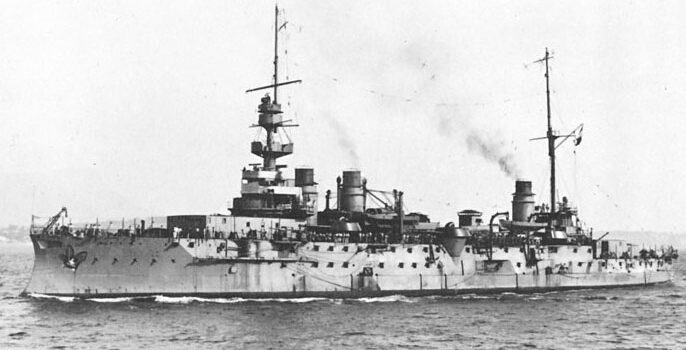
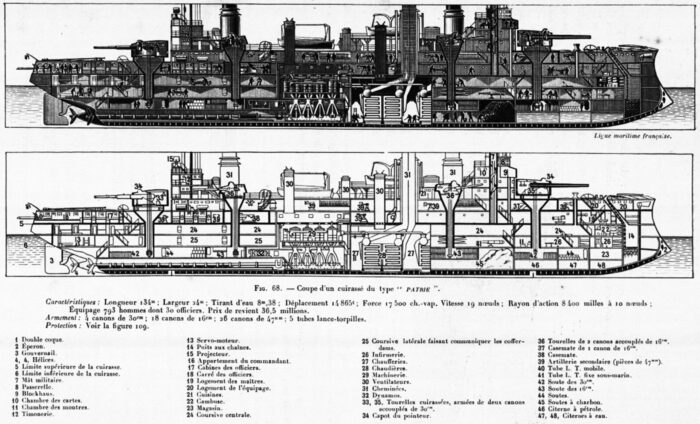
 Latest Facebook Entry -
Latest Facebook Entry -  X(Tweeter) Naval Encyclopedia's deck archive
X(Tweeter) Naval Encyclopedia's deck archive Instagram (@navalencyc)
Instagram (@navalencyc)





 French Navy
French Navy Royal Navy
Royal Navy Russian Navy
Russian Navy Armada Espanola
Armada Espanola Austrian Navy
Austrian Navy K.u.K. Kriegsmarine
K.u.K. Kriegsmarine Dansk Marine
Dansk Marine Nautiko Hellenon
Nautiko Hellenon Koninklije Marine 1870
Koninklije Marine 1870 Marinha do Brasil
Marinha do Brasil Osmanlı Donanması
Osmanlı Donanması Marina Do Peru
Marina Do Peru Marinha do Portugal
Marinha do Portugal Regia Marina 1870
Regia Marina 1870 Nihhon Kaigun 1870
Nihhon Kaigun 1870 Preußische Marine 1870
Preußische Marine 1870 Russkiy Flot 1870
Russkiy Flot 1870 Svenska marinen
Svenska marinen Søværnet
Søværnet Union Navy
Union Navy Confederate Navy
Confederate Navy Armada de Argentina
Armada de Argentina Imperial Chinese Navy
Imperial Chinese Navy Marinha do Portugal
Marinha do Portugal Mexico
Mexico Kaiserliche Marine
Kaiserliche Marine 1898 US Navy
1898 US Navy Sovietskiy Flot
Sovietskiy Flot Royal Canadian Navy
Royal Canadian Navy Royal Australian Navy
Royal Australian Navy RNZN Fleet
RNZN Fleet Chinese Navy 1937
Chinese Navy 1937 Kriegsmarine
Kriegsmarine Chilean Navy
Chilean Navy Danish Navy
Danish Navy Finnish Navy
Finnish Navy Hellenic Navy
Hellenic Navy Polish Navy
Polish Navy Romanian Navy
Romanian Navy Turkish Navy
Turkish Navy Royal Yugoslav Navy
Royal Yugoslav Navy Royal Thai Navy
Royal Thai Navy Minor Navies
Minor Navies Albania
Albania Austria
Austria Belgium
Belgium Columbia
Columbia Costa Rica
Costa Rica Cuba
Cuba Czechoslovakia
Czechoslovakia Dominican Republic
Dominican Republic Haiti
Haiti Hungary
Hungary Honduras
Honduras Estonia
Estonia Iceland
Iceland Eire
Eire Equador
Equador Iran
Iran Iraq
Iraq Latvia
Latvia Liberia
Liberia Lithuania
Lithuania Mandchukuo
Mandchukuo Morocco
Morocco Nicaragua
Nicaragua Persia
Persia San Salvador
San Salvador Sarawak
Sarawak Uruguay
Uruguay Venezuela
Venezuela Zanzibar
Zanzibar Warsaw Pact Navies
Warsaw Pact Navies Bulgaria
Bulgaria Hungary
Hungary

 Bundesmarine
Bundesmarine Dutch Navy
Dutch Navy Hellenic Navy
Hellenic Navy Marina Militare
Marina Militare Yugoslav Navy
Yugoslav Navy Chinese Navy
Chinese Navy Indian Navy
Indian Navy Indonesian Navy
Indonesian Navy JMSDF
JMSDF North Korean Navy
North Korean Navy Pakistani Navy
Pakistani Navy Philippines Navy
Philippines Navy ROKN
ROKN Rep. of Singapore Navy
Rep. of Singapore Navy Taiwanese Navy
Taiwanese Navy IDF Navy
IDF Navy Saudi Navy
Saudi Navy Royal New Zealand Navy
Royal New Zealand Navy Egyptian Navy
Egyptian Navy South African Navy
South African Navy






























 Ukrainian Navy
Ukrainian Navy dbodesign
dbodesign